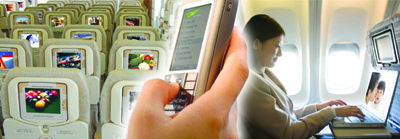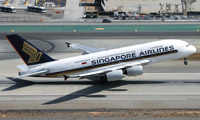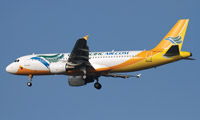Special Report: IFE & Communications
IFE REVOLUTION
Asia-Pacific airlines are on an inflight entertainment (IFE) spending splurge, but it comes amidst a growing debate about the future of IFE and whether seat-back entertainment could become yesterday’s technology
October 1st 2012
When one of the Asia-Pacific’s recognized leaders in inflight service, Singapore Airlines (SIA), disclosed it was spending $400 million to equip its aircraft with advanced inflight entertainment systems last month, in a bid to maintain advantage over rivals, it was hardly a surprise. Read More »
But another announcement, just a few days earlier, cemented a growing belief that keeping passengers entertained is heading along a new technology highway dominated by Wi-Fi, smartphones and personal tablets such as the iPad. For IFE read IFEC, or inflight entertainment and communications.
 |
| Wi-Fi along with personal electric devices like smartphones, laptop computers and iPads could eventually seal the fate of seat-back entertainment |
Carriers are rushing to take advantage of the explosion in the use of personal electronic devices by their customers.
While some operators, particularly low-cost carriers (LCCs), are already offering, or renting out, iPads loaded with entertainment to passengers, more, including full service airlines, are launching in-aircraft Wi-Fi to stream content directly to their customers’ own devices.
SIA, in partnership with leading connectivity provider OnAir, owned by information technology provider, SITA, formally launched In-Flight Connectivity last month, part of a $50 million programme to bring high altitude internet and mobile data services to customers.
The system is currently deployed on 14 aircraft in the fleet, including all five of SIA’s A340-500s, which fly the world’s longest non-stop flights between Singapore and Newark and Los Angeles in the U.S.
Travellers can surf the internet, send and receive emails on smartphones and other electronic devices and send and receive SMS text messages with compatible mobile phones.
The technology will be progressively rolled out across all of SIA’s long-haul A380-800, A340-500 and B777-300ER aircraft in the next two years.
SIA is not alone in setting out on this super highway. Other carriers in the region, including Garuda Indonesia, All Nippon Airways, Cebu Pacific and Thai Airways International are introducing the OnAir Wi-Fi service.
Philippine Airlines (PAL) is about to include Apple iPads among its inflight entertainment options onboard all trans-Pacific flights. Qantas Airways is launching QStreaming, which makes IFE available on passenger iPads on its domestic B767 fleet, following a successful trial earlier this year.
In the meantime, there has been a stream of announcements from Asia-Pacific operators who plan to fit the latest IFEC on new planes.
They include Malaysia Airlines (A380s), Air India (B787s) and China Southern Airlines (B777s), all fitting Thales TopSeries IFEC systems, as well as Taiwan’s TransAsia Airways, which has selected Rockwell Collins’ PAVES™ 2 for its new A320s.
Paying customers are not the only ones involved in the high-flying mobile communications revolution.
Qantas will be the launch customer for Boeing’s Onboard Performance Solution for iPad, which gives pilots the ideal speeds and engine settings for any aircraft, in any weather, on any runway. From next February, Japan’s All Nippon Airways (ANA) will begin equipping its 2,500 flight crew with an iPad (see separate story).
Airlines are reacting to trends. Few people now travel without a smartphone or tablet device. Statistics show 10 years after becoming broadly available, smartphones have reached about 40% of the U.S. market. Their use in the Asia-Pacific is fast approaching that figure.
In Japan alone, nearly 20 million people own smartphones, up 28% from last year. This year, shipments of the phones have increased nearly 90% over 2011. The use of tablets, such as the iPad, is increasing at an even faster rate. SITA says some 330 million tablets will be sold worldwide by 2015.
In its latest airline IT trends survey, SITA found nine out of 10 airlines plan to engage with passengers through mobiles by 2015. They believe smartphones can support most, if not all, customer facing interactions, including customer service, commerce, inflight entertainment and passenger processing.
 |
| Singapore Airlines: spending $400 million on upgrading its inflight entertainment products, including internet and mobile data services for passengers |
It said 93% of airlines have mobile services for passengers as a top investment priority in the next three years, with 58% investing in major programmes.
The trend has raised serious questions about the future of IFE, including the potential to ditch expensive seat-back solutions and replace them with wireless streaming of offerings direct to passenger electronic devices.
It would be an attractive alternative, allowing airlines to remove IFE hardware, and therefore significant weight, from their fleet that would save on fuel costs. Often fitted beneath the seat, taking out the hardware would also give passengers more legroom.
The concept is on some airline agendas. Cathay Pacific Airways chief executive, John Slosar, said in a recent interview that given the popularity of tablets passengers “no longer need some of the onboard entertainment facilities, for example, seat-back personal TV screens.”
But there was a rider: Slosar made it clear Cathay wouldn’t be removing in-seat systems any time soon. A Cathay spokesperson told Orient Aviation: “We continue to monitor trends in offering passengers the best choice of inflight entertainment. At the moment, Cathay Pacific is unlikely to implement any new system for the next five to six years.”
While it is spending money on Wi-Fi products, SIA also remains committed to seat-back systems. Its $400 million spend includes Panasonic Avionics equipping more than 40 planes with a system that can provide broadband internet and global live television.
SIA will be the launch customer for Panasonic’s new eXr system, which will offer the latest video screen technology and touch-screen handsets in all classes of travel, powering the carrier’s KrisWorld entertainment system.
Tan Pee Teck, senior vice-president product and services, told Orient Aviation: “We have always been open to exploring all developments and possibilities in IFEC technology.”
But he said SIA continued to see “a good future” for in-seat systems. “The next generation of systems will have many innovative features that will enable us to maintain our status as a leader in this area,” said Tan.
“At the same time, we are open to evaluating other technologies and options as well. But it is, of course, about more than just hardware. Having strong content is extremely important. We are constantly expanding the on-board library of movies, TV programmes, audio CDs and much more.”
 |
| Cebu Pacific Airways: one of a number of Asia-Pacific carriers introducing Wi-Fi service on board |
Qantas QStreaming is also a partnership with Panasonic, using its eXW solution, streaming IFE direct to passenger iPads.
“We’re looking at ways to evolve this technology platform even further with our partner Panasonic to bring new standards of inflight entertainment to our customers,” said Qantas Domestic chief executive, Lyell Strambi.
Peter McLaughlin, executive director of Australia-based inflight entertainment content and technical services provider, Stellar Inflight, said airlines were looking at ways to remove weight from the aircraft. Upgrading the technology of IFE systems was one area where they could cut back.
“But I don’t think they are going to rip seat-back systems out any time soon,” he said. “But as new aircraft come off the line and as Wi-Fi becomes a little more common on aircraft, particularly on international flights, perhaps they are not going to order as many in-seat devices as they have in the past. It will take some time for that to catch up.”
Indeed, Stellar won several significant contracts this year which involve providing content suitable for iPads, including SIA’s new budget carrier Scoot, Virgin Australia, Jetstar, Malaysia’s AirAsia group and Turkish Airlines.
“Whatever equipment they choose they are always going to need content,” said McLaughlin. “They can have whatever hardware they like, whether it is wired into the seat or whether it is a supplied tablet or whether eventually it is their own device picking up the movies, TV shows or audio. For an airline content is still going to be the most important thing.”
Analysts and industry insiders point out there are several major hurdles to overcome before a legacy airline would consider removing in-seat systems. While it will remove weight it would also be an extremely costly exercise.
“And what if you have a family of four travelling with only one or two tablets between them. You would have to carry a supply of tablets on board and that also would add weight to the aircraft,” said one airline IFE executive.
Critics also suggest there are difficulties in streaming for hundreds of devices simultaneously, although this is denied by providers who say a single wireless access point (WAP) can support about 50 people. Thus a five-WAP configuration in an aircraft could support 250 people using their devices at the same time.
 |
| 'Hollywood has always had an issue about any new technology where first release movies are going to be shown anywhere, and the aircraft is one of them' |
| Peter McLaughlin Executive Director Stellar Inflight |
Yet another decision for carriers is whether to charge for the service or not. Recent statistics in the U.S., where around 30% of domestic flights already offer Wi-Fi access, show that less than 5% of passengers are willing to pay for the service.
While comparable statistics are not known for Asia-Pacific operators who offer Wi-Fi access, most of them do charge. For example, SIA last month offered promotional price plans for wireless internet access.
Available until November 30, the charge is US$25 for 30 megabytes of data and $10 for 10 megabytes. Previous plans cost $29.95 for 26 megabytes and $11.95 for 10 megabytes.
Another issue is Hollywood and the supply of first-release movies to airlines. Stellar’s McLaughlin said film studios are extremely nervous about movies being streamed over Wi-Fi to passenger devices because of piracy issues.
“Hollywood has always had an issue about any new technology where first release movies are going to be shown anywhere and the aircraft is one of them,” he said.
“Until they are convinced the security surrounding the Wi-Fi on airlines is there they will be sceptical. I believe the time will come when they will be convinced it is OK.”
The surge in passenger use of personal electronic devices has sparked new concerns about the impact they may have on aircraft systems, such as navigation instruments.
It has led to a fresh study by the U.S. Federal Aviation Administration (FAA). Last month, it moved to set up a group that will include representatives from the mobile technology and aviation manufacturing industries, pilot and flight attendant groups, airlines and passenger associations, to look at the rules governing inflight use of the devices.
Airlines currently tell passengers not to use iPods, laptops and other devices while planes are taking off and landing. Under current rules, aircraft operators are left to determine themselves that personal electronics do not cause dangerous radio frequency interference in order to approve them for use during flights.
“We’re looking for information to help air carriers and operators decide if they can allow more widespread use of electronic devices in today’s aircraft,” said acting FAA Administrator, Michael Huerta. “We also want solid safety data to make sure tomorrow’s aircraft designs are protected from interference.”
Meanwhile, there isn’t any shortage of IFEC products from IT providers. Apart from SITA’s OnAir system and systems from Thales, Rockwell, Panasonic and others, Lufthansa Systems last month launched Board Connect, a WiFi network that comprises a server on board the aircraft plus several wireless access points in the cabin.
Said programme head, Norbert Müller: “As no wiring is required to transmit data in the cabin, airlines can install Board Connect during routine maintenance or night stops without the need for additional ground time.”
He said the weight savings generated by the elimination of wiring and data transmission hardware reduces fuel consumption on a B767-300ER by more than 80 tonnes a year. German carrier, Condor, will be the launch customer for Board Connect.
The general view within the airline industry is that although Wi-Fi streaming of IFE will become part and parcel of a carrier’s entertainment offering, no one will be reading the funeral rites over seat-back entertainment anytime soon.